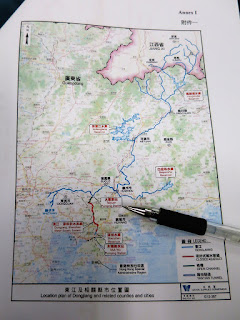Hong Kong Accreditation Service
(HKAS) organized a training entitled “HKAS ISO 50001 Seminar for Certification
Bodies” on 4th Feb 2016. The International Organization for
Standardization (ISO) related the international standard ISO 50001 for energy
management system (EnMS) as a globally accepted framework for energy management
in 2011. In 2014, ISO also released the ISO 50003 on “Requirement for bodies
providing audit and certification of energy management systems”. Before the seminar, we took a group photo
with speaker Ms. Deann Desai (Project Manager, Georgia Institute of Technology,
USA) and Dr. M.K. Kwok (Senior Accreditation Officer, HKAS).
Dr. M.K. Kwok (Senior
Accreditation Officer, HKAS) gave an opening remark and introduced our guest
speaker Ms. Deann Desai (Project Manager, Georgia Institute of Technology, USA).
Ms. Desai currently served as the administrator and secretary and as an expert
for the U.S. Technical Advisory Group for Technical Committee 242 and 257.
In the beginning, Ms. Deann Desai
briefed the history of ISO 50001:2011 Energy Management System which had been
published on 15 June 2011. It expected
to influence up to 60% of the world’s energy use by energy planning and
efficiency. ISO 50001 is important
because of reducing “environmental and societal costs” and enhancing “Energy
performance”, “Green House Gas impact”, “Positive contributions toward reducing
depletion of energy resources”.
Then Ms. Desai said ISO 50001
provided a framework for energy management using data-driven decision making.
This ISO standard was requested by the United Nations Industrial Development Organization (UNIDO) which
had recognized industry’s need to mount an effective response to climate change
and to the proliferation of national energy management standards. Then she
briefed the summary of ISO Survey 2014 and found that ISO 50001 increase 40%
from 2013 to 2014.
Some definitions were reviewed
below.
Scope –
decisions, activities, and facilities, which are going to be included in the
EnMS. (note: can include multiple boundaries)
Boundary –
physical, site, or other organizational limits associated with the scope.
Energy consumption – quantity of energy applied (consumed)
Energy use
– manner or kind of application of energy (note: ventilation, lighting,
heating, cooling, transportation, processes, production lines, etc.)
Continual improvement – recurring process which results in enhancement of energy performance
and the energy management system (note: achieve in overall energy performance,
consistent with energy policy)
Energy performance – measurable results related to energy efficiency, energy use and
energy consumption.
Ms. Desai told me that Energy
Intensity was different in different industry and some would use Energy Output
/ Energy Input or Energy Input / Energy Output or or Energy Use / Product. For automotive
industry, people would ask how many energy consume to build a car.
After that Ms. Desai briefed the
ISO 50000 family and their relationship as following diagram.
Some barriers to industrial
energy efficiency were showed in the following diagram. The only solution was that top management
need to engaged in the management of energy on an ongoing basis. Energy
efficiency should be integrated into daily management and operational
practices.
The core values of Energy
Management System were separated into Management System and Energy Performance
in diagram below.
The following diagram showed that
the great improvement was found initially but become steady afterward. However, it could be continual improvement
after energy save culture created in the organization.
Energy Planning process included “Legal
and Other Requirement”, “Energy Review”, “Baseline”, “EnPI”, “Objectives,
Targets, Action Plans” and “Review and Update”.
She said the measurement plan
based on “What kind of data I expected to see?” Key characteristics of Energy Performance
were briefed.
Finally, she briefed the draft
standard of ISO 50002 for Energy Audit and ISO 50003:2014 for requirements for
bodies providing audit and certification of EnMS. Lastly, Ms. Desai introduced ISO 50001 Global
Impacts Research Network (ISO 50001 GIRN) and Energy Management Working Group
(EMWG) to us.
Reference:





























